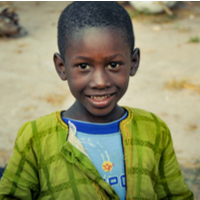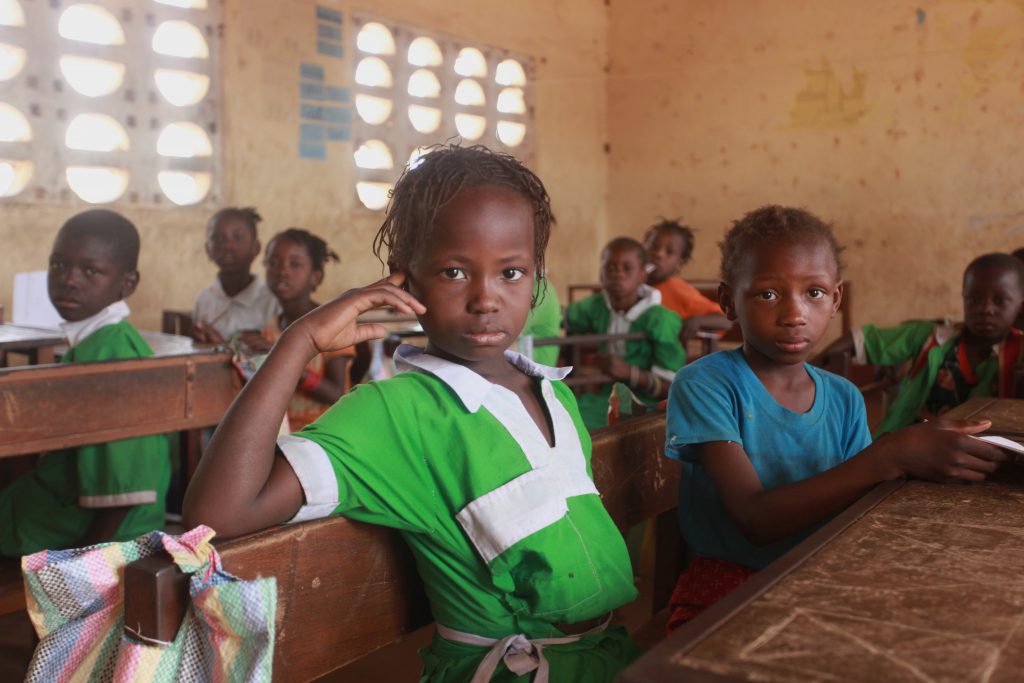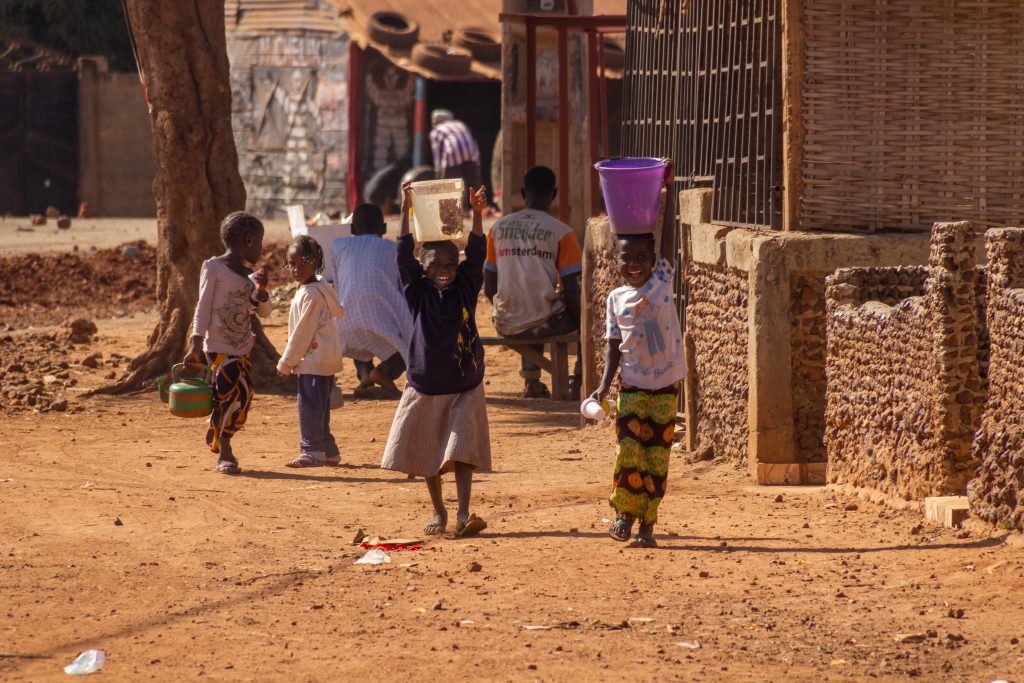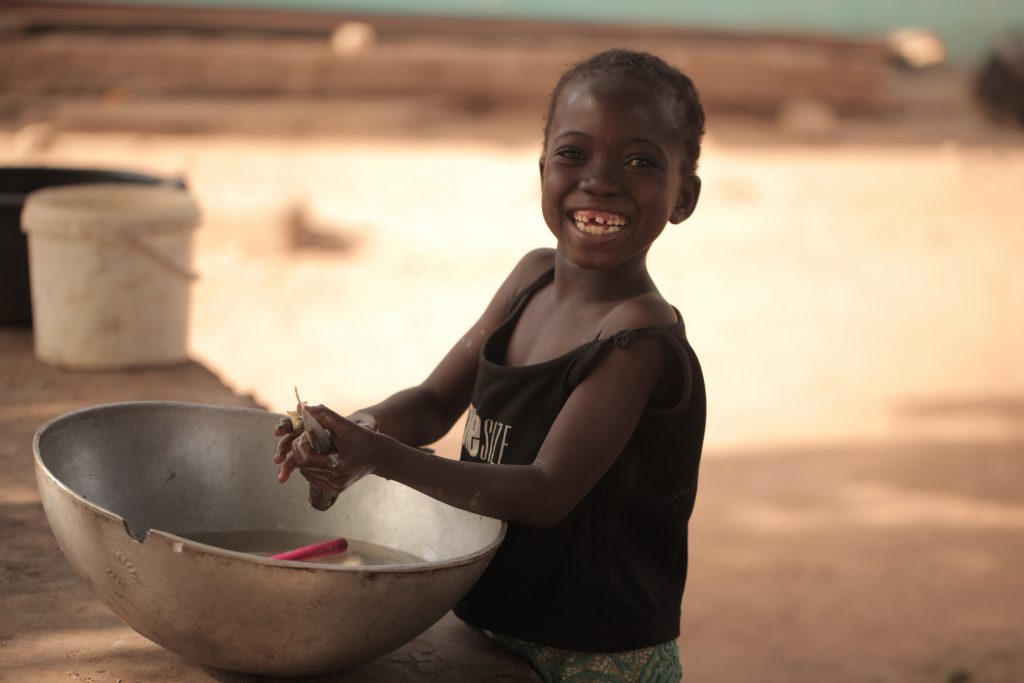Realizing Children’s Rights in Gambia


The Republic of the Gambia has ratified the United Nations Convention on the Rights of the Child 1989 (UNCRC 1989) in 1990. The country has also ratified the Optional Protocol to the UNCRC 1989 on the sale of children, child prostitution and child pornography. Unfortunately, child prostitution, child sexual abuse and trafficking of children for sexual purposes is a significant problem in the Gambia unlike in other parts of the world.

Children’s Rights Index: 5,94 / 10
Black level : Very serious situation
Population: 2.28 million
Pop. ages 0-14: 44.1%
Life expectancy: 61.7 years
Under-5 mortality rate: 51.7 ‰
The Gambia at Glance
The Gambia is the smallest country in West Africa. The country is bordered by the Atlantic Ocean and Senegal to the north, east and south (Secretariat, Commonwealth, 2020). The country is also one of the most densely populated countries on the continent. Pre-colonial history of the Gambia reveals that the country is closely interlinked with neighbouring country Senegal and it was only during the late 19th century that a distinction was made between the Gambia and Senegal; until then the region was referred to as Senegambia (Clark, 2020).
As a result of the Berlin Conference in 1884, a colonization of Africa happened. In 1889, France ceded control of the Gambia River to the United Kingdom, and the present-day boundaries of the Gambia were drawn. By 1965, the Gambia became independent from the United Kingdom and five years later a new constitution, approved by a referendum in April 1970, transformed the nation into a republic (Clark, 2020).
The Gambia River is the country’s major waterway. It starts from Guinea and flows through Senegal and the Gambia (Secretariat, Commonwealth, 2020). The Gambia River is one of the finest waterways in Africa and the only western African river that is easily accessible to oceangoing shipping. It constitutes a unifying factor for the independent state of the Gambia, which consists of a narrow strip of land along both banks of the river.
Status of Children’s Rights [1]
The Gambia ratified the UNCRC 1989 on the 8th of August 1990 (OHCHR, 2020).The Gambia has also ratified key international treaties aiming to protect the wellbeing of children and safeguard their rights; these Optional Protocols are on the Sale of Children, Child Prostitution and Child Pornography (ratified on the 8th April 2010) and on the Involvement of Children in Armed Conflicts (ratified on the 27th September 2019) (OHCHR, 2020).
However, the Gambia, like the majority of the states, is yet to ratify the Optional Protocol Communication Procedure 2011 (United Nations Treaty Collection, 2020). The Optional Protocols complement and add to existing treaties. They are optional because the obligations may be more demanding than those in the original convention (UNICEF, 2020). Thus, states must independently decide whether or not to be bound by them (UNICEF, 2020). Optional Protocols are treaties in their own right and are open to signature, ratification or accession.

From a regional standpoint, the Gambia has ratified the African Charter on the Rights and Welfare of the Child 1990 (ACRWC 1990) on the 14th December 2000 (ACERWC, 2020). Additionally, the Gambia has ratified the Protocol to the African Charter on Human and Peoples Rights on the Rights of Women in Africa (African Union, 2020). The Protocol makes specific references to children and to girls in particular. Moreover, the Preamble calls for the condemnation and elimination of any “practice that hinders or endangers the growth and affects the physical, emotional and psychological development of women and girls” (UN, 2020).
Furthermore, the Protocol explicitly condemns harmful practices such as female genital mutilation (FGM) and scarification that affect the fundamental human rights of women and girls and are contrary to recognized international standards (UN, 2020). According to the Constitution of the Gambia of 1997, under Article 29 subsection 1 it adheres to ensuring that all children born in the Gambia have the right to identity and the best interests of the child is acknowledged (Human Rights Library, 2020). Article 30 of the Constitution recognizes the fundamental right to education for all children. The Constitution of the Gambia is further supplemented through the Children’s Act of 2005 (The CA 2005). The Children’s Act is the principal law concerning children’s rights in the Gambia (African Child Forum, 2020).
The CA 2005 does indeed cover the fundamental principles of children’s rights; however this has not deterred its critics. The UN Committee on the Rights of the Child has voiced concern that the Act “fails to cover all areas under the Convention, including issues related to child marriage, female genital mutilation and child labour, that it has not been effectively enforced and that it has not been sufficiently disseminated” (UN Committee on the Rights of the Child (CRC), 2015). The comments made by the UN Committee on the CA are valid and the state of the Gambia must seek to address these issues which continue to persist and cause detrimental damage to the rights of the Gambian children.
Addressing the Needs of Children
Right to Education
In 2010, there were still major gaps in ensuring that the most disadvantaged children are provided with their right to education. (UNICEF, 2011). Some 31.6% of children aged 7-15 years were out of school (The Gambian Ministry of Basic and Secondary Education (MoBSE)/World Bank/UNESCO, 2010). The most disadvantaged children are in the eastern parts of the country, where a poor Gambian girl has virtually no chance of completing primary education (The Gambian Ministry of Basic and Secondary Education (MoBSE)/World Bank/UNESCO, 2010). Nearly half of the education costs have to be funded by household resources, representing a significant burden on many families.
During the last ten years, the Gambia has sought to develop its early childhood activities and especially its preschool education services (UNICEF, 2018). From 2007 to 2017, there was a fairly significant increase in preschool coverage: it rose from 20% in 2007 to 38% in 2017. The enrolment rate rose approximately from 42,400 children in 2007 to a little under 104,000 in 2017 (UNICEF, 2018). However, it remains that 62% of children lack access to preschool activities. Under its Early Childhood Development Policy 2016-2030, the country plans to increase preschool coverage to 60% by 2030 (Ministry of Basic and Secondary Education (MoBSE), 2016).

The Gambia’s education sector is expanding annually, and this poses a challenge to the government to meet the growing funding requirements needed to match this steady growth in terms of classrooms, learning materials and teachers (UNICEF, 2020). The education sector has significant bottlenecks that hinder equitable quality service-delivery (UNICEF, 2020). Preschool education is not adequately developed, both in relation to programmes and capacity to lay a solid foundation for life-longing learning (UNICEF, 2020).
Additionally, children with disabilities have limited access to education due to both social norms and structural limitations (UNICEF, 2020). Secondary education for girls is largely unavailable due to the higher value placed on marriage over education and career development. The role of boys as future family breadwinners also results in some families pushing their teenage boys to embark on the dangerous journey to Europe in search of wealth to provide immediate support for their families (UNICEF, 2020).
Right to Health
Despite the best efforts to promote the standard of health which is necessary for the development of children, the health sector remains relatively weak, with deteriorating physical infrastructure, lack of adequate supplies and equipment (UNICEF, 2020). According to the Multiple Indicator Cluster Surveys (MICS) in 2018, under-five mortality in the Gambia is at 57 per 1,000 live births, infant mortality is at 41 per 1000 live births and neonatal mortality is at 31 per 1,000 live births (Multiple Indicator Cluster Survey, 2019).
This indicates that the health sector is making progress in reducing mortality rates. In addition, the prevalence of stunting in children 0-59 months has reduced from 23.4% (Multiple Indicator Cluster Survey, 2010) in 2010 to 19.0% in 2018. Stunting, however, remains relatively high in rural areas such as Kuntaur with 26.6%, Janjangbureh with 24.3% and Kerewan with 20.8%, compared to 16.6% in Banjul and 14.4% in Kanifing Municipality. The statistics confirm the marked disparities between rural and urban areas (UNICEF, 2020).
Despite these challenges, the Gambia continues to make gains in primary health care (PHC) coverage, especially in immunization coverage (UNICEF, 2020). The Gambia has been consistently registering immunization coverage of over 90% for three doses of diphtheria, tetanus and pertussis (DTP), often seen as the measure of the national performance on immunization. However, with the increase in the number of children vaccinated, there has been a near-stagnation in immunization coverages over the past few years with reported coverages of 92% in 2017 and 93% in 2018 (UNICEF, 2020).
Malnutrition in all its forms remains a major challenge in the Gambia (UNICEF, 2020). Many children, especially in the rural areas, are poorly nourished, reason being several issues, ranging from institutional arrangements and shortfall in domestic resources to challenges related to the quality-of-service delivery (UNICEF, 2020). Some of the issues highlighted relate to inadequate staffing, insufficient and unpredictable funding and the need for stronger coordination of nutrition activities (UNICEF, 2020).
The Gambia is committed to closing the remaining gaps under the Sustainable Development Goals (SDGs), in particular to tackle hunger, to reduce food insecurity, malnutrition and promote sustainable agriculture and stronger food systems by 2030 (United Nations World Food Programme, 2020). Through the National Development Plan (NPD) 2018-2021, the Government of the Gambia is committed to strengthening the productive sectors and ensuring optimal nutrition for its population and food self-sufficiency in the country. This is to be done specifically by ending hunger and ensuring access to safe, nutritious and sufficient food all year round for all people, in particular the poor and people in vulnerable situations, including women and children under the age of 5 (United Nations World Food Programme, 2020).
Right to Water and Sanitation
In the Gambia, 61.8% of the population has access to improved sanitation with 1% still practicing open defecation and only 30.9% of the population practicing hand washing with soap or other detergents (UNICEF, 2020). Tremendous efforts have been made to ensure accessibility to safe drinking water over the past years (UNICEF, 2020). Children and their families in the Gambia have gained improved and equitable access to safe drinking water with 90% of the population accessing improved water sources in 2018, which is a progress from 2010 when 86% of the population had this access.
However, only 34% (one third) of households are using safely managed drinking water services. Furthermore, according to the MICS survey, 84,724 children (43,512 girls and 41,212 boys) have gained access to safe drinking water, sanitation services, and have adopted improved hygiene practices and behaviours, contributing to the national proportion of 90% population accessing improved water sources (Multiple Indicator Cluster Survey, 2019). With 62% of improved sanitation facilities, 31% of the population has been practicing hand washing with soap (Multiple Indicator Cluster Survey, 2019).

In line with the SDG indicator for sanitation, only 47% of the household population have access to a basic level of service (Multiple Indicator Cluster Survey, 2019). The proportion of household members with a hand washing facility where water and soap or detergent are present remains low at 31%, compared to 30.3% in 2010, which requires intensified efforts (Multiple Indicator Cluster Survey , 2010). Inadequate water supply and improved sanitation in schools, as well as health care facilities and public places still remain a challenge (UNICEF, 2020).
Diarrhoea, which is linked to poor sanitation and hygiene practices accounts for 7% of under-five mortality and poor hygiene practices still contribute to high malnutrition and neonatal infection (UNICEF, 2020). Maintaining high immunization coverage and improving quality and equitable access to vaccination services to ensure all children in all communities are reached with all their basic vaccination is paramount (UNICEF, 2020). Low coverage among poor or marginalized groups threatens to compromise gains made in expanding coverage and creates an opportunity for potential disease outbreaks (UNICEF, 2020). This further highlights the importance of immunizing children in order for them to have the opportunity to thrive and to have a better chance of realizing their full potential (UNICEF, 2020).
Right to Identity
Birth registration is an inherent right of every child set out in Article 6 of the ACRWC 1990 where it is stated that “every child shall be registered immediately after birth” (ACERWC, 2020).The lack of birth registration can cause severe damage to the survival, development and protection of children in various ways (UNICEF, 2020). Birth registration ensures children have access to basic services such as health, social protection, and education, and protects children from child labour, exploitation, trafficking and child marriage (UNICEF, 2020).
Article 7 (2) of the CA 2005 also clearly states that “the birth of every child shall be registered” (African Child Forum, 2020). Despite this clear obligation, birth registration in the Gambia still requires significant improvements. There has been an increase from 52.5% in 2010 to 57.9% in 2018, according to the MICS surveys for registered children, but only 32.3% of children under the age of five have actual birth certificates (UNICEF, 2020) (Multiple Indicator Cluster Survey , 2019). Additionally, there is gender disparity in birth registration in the Gambia, as boys are registered more than girls at 59.5% and 56.2%, respectively (UNICEF, 2019). Barriers to registration in the Gambia include the inflexibility of the birth registration process, low awareness about the importance of birth registration and distance to the nearest registration facility.
Risk Factors → Country-Specific Challenges
Child Trafficking
The Gambia is a source, transit and destination country for trafficking in children for sexual purposes (ECPAT International, 2015). Both Gambian and foreign children, from nearby West African countries, are trafficked, particularly to Banjul for sexual exploitation by Gambian nationals and tourists. The Gambia’s economy is heavily reliant on the tourism industry; in fact, the Gambia’s economy draws nearly one fifth of its GDP from tourism (Index Mundi, 2021). This heavy reliance on tourism, coupled with high levels of poverty and a weak child protection system can leave children in the Gambia extremely vulnerable to commercial sexual exploitation.
The protection of children from trafficking for sexual purposes is one of the more developed areas of the law in the Gambia. There are extensive legislative and policy provisions to combat, protect and assist children who are victims of trafficking (ECPAT International, 2015). The Trafficking in Persons Act 2007 (Trafficking Act 2007) explicitly prohibits all forms of trafficking, including trafficking in children for sexual purposes (African Child Forum, 2021). The Trafficking in Persons (Amendment) Act of 2010 (Gazette Notice, 2021), criminalized sex trafficking and labour trafficking, and prescribes penalties of 50-years-to-life imprisonment and a fine of between 50,000 and 500,000 dalasi ($980-$9,800) (US. Department of State, 2021).
These penalties are sufficiently stringent and, with respect to sex trafficking, commensurate with penalties prescribed for other serious crimes such as rape (US. Department of State, 2021). International organisations have reported that official corruption, including police officers requesting bribes to register trafficking complaints, has impeded law enforcement efforts (US. Department of State, 2021).
Child Labour & Exploitation
During the past few years, the Gambia has made moderate efforts to eliminate the worst forms of child labour. The Government has signed and ratified key international conventions concerning child labour such as the International Convention on the Worst Forms of Child Labour (International Labour Organization, 2021), the International Convention on Minimum Age (International Labour Organization, 2021) and the International Convention on the Protection of the Rights of All Migrant Workers and Members of Their Families (OHCHR, 2020).
Additionally, the Gambia has also created the National Coordination Committee on Child Labour to conduct child labour investigations and streamline the process to prosecute child labour perpetrators (Bureau of International Labour Affairs , 2021). Moreover, the Government has increased the number of Community Child Protection Committee members from 31 to 70 and founded 15 child protection centres to monitor, identify and report potential cases of worst forms of child labour. However, gaps still remain to adequately protect children from child labour which is mostly prevalent in the tourism sector (where children are sexually exploited) and in agriculture (especially in rural areas, street begging and domestic work in urban areas) (International Labour Organization , 2021).

Part of the issue is the lack of harmonization of key provisions such as those in the CA 2005 and the Labour Code (International Labour Organization, 2021) that regulate apprenticeships and ensure that children are at least 14 years of age in workplace-based apprenticeships (Bureau of International Labour Affairs , 2021). Furthermore, the legal working age in the Gambia is 16 years and for hazardous work the age is 18 (Newgarden, 2021). Yet, children often work in order to support their families financially and the government fails to conduct inspections.
Boys in urban areas work as shoe-shiners or street sweepers and some undertake hazardous jobs such as hauling heavy objects that could lead to future health problems. Girls commonly work in domestic service or as street vendors selling fruit or water. Both boys and girls in rural areas work on farms (Newgarden, 2021). Children between the ages of 14 and 16 commonly work in physical-labour industries like sewing, brick-making or masonry often for exhausting hours in unethical or unsafe conditions. Furthermore, this deprives children of their right to education and hinders their development.
Another challenge the Gambia faces is child prostitution. The CA 2005 prohibits the prostitution of children and complies with international standards, providing serious punishment for child prostitution and related offences (ECPAT International, 2015). Despite having a clear definition of a child as anyone under 18 years of age and providing under the law no child is capable of contracting a valid marriage, this provision is subject to any applicable personal law and there is no law providing the minimum age for sexual consent (ECPAT International, 2015). Furthermore, although there are significant laws for protecting children against prostitution, the implementation of these laws remains piecemeal. This is due to a lack of enforcement resources and a general lack of awareness of child rights.
Child Marriage and FGM/Cutting
According to the MICS of 2018, 50.6% of girls under the age of 14 years old and 27.3% of girls between 0 to 4 years old have undergone FGM /cutting (UNICEF, 2020). Basse, the most rural region of the country, has the highest prevalence of FGM at 96.7% of women aged 15 to 49. Banjul, the most urbanised area, has the lowest prevalence at 47.4% (28TooMany, 2018). The Women’s (Amendment) Act 2015 addressed the issue of harmful practices for the first time in the Gambia by introducing Section 32A (Prohibition of female circumcision) and Section 32B (Accomplices to female circumcision) (Gazette Notice, 2015).
Despite FGM now being recognised as illegal, this provision still has shortcomings, since it fails to address the issue of cross-border FGM. In some countries where FGM is illegal, the practice has been pushed underground and across borders to avoid prosecution (28TooMany, 2018). The Gambia borders Senegal, where prevalence remains as high as 77.8% in some southern regions, despite national legislation prohibiting the practice (28TooMany, 2018). The movement of families and circumcisers across border to perform FGM and avoid prosecution remains a problem across West Africa to which girls living in border communities are particularly vulnerable (28TooMany, 2018).
In regard to child marriage, about one third (34.2%) of women aged 20-49 year are married before the age of 18 (UNICEF, Child Protection). While 8% of girls are married before their 15th birthday, the lowest median ages of marriage are in Kuntaur and Basse. The CA 2005 under Section 28 clearly states that “no child is capable of contracting a valid marriage”. This is subject to “personal law” which includes Sharia law. Sharia law provides that Muslims are allowed to marry upon physical maturity which may be before 18 years old (ECPAT International, 2015). This is particularly alarming considering that 90% of the Gambian population are Muslim.
Due to traditional cultural and religious reasons, cases relating to early or forced marriage are not viewed as inappropriate and oftentimes go unreported as a result of privacy concerns or fear of social stigmatisation (ECPAT International, 2015). Another factor contributing to child marriages is poverty, since girls from the poor households are more likely to marry already as children (Girls not Brides, 2021). Families sell about 30% of girls under the age of 18 into marriage, in exchange for livestock and other material goods that can help their families (Newgarden, 2021).
Environmental Challenges
The Gambia faces several environmental challenges. One of them is drought which remains a major natural hazard with about 30% drop in annual rainfall within the last 30 years (Africa and the World, 2021). Consequently, this disrupts agriculture production and causes scarcity of drinking water and water for domestic purposes in several areas across the country. Deforestation which leads to soil erosion and desertification also only compound other problems already existing in most areas of the country (Africa and the World, 2021).
Given that the poor rural population depends on the availability of natural resources for their livelihoods, a nexus of issues closely links poverty alleviation and environmental protection (United Nations Development Programme, 2021). Efforts to conserve natural resources and reduce pollution may not succeed without opportunities for local people to feed themselves (United Nations Development Programme, 2021). The environment poverty nexus coupled with impact of climate change and climate variation on key sectors of the Gambian economy (i.e. forestry, fisheries, agriculture, water resources, and energy) presents hurdles in addressing the Gambia’s environmental challenges, which is a prerequisite for economic development.
Written by Igi Nderi
Last updated on January 6, 2021
References:
28TooMany. (2018). The Gambia: The Law and FGM. Banjul: 28TooMany.
ACERWC. (2020, December 2). Ratifications Table. Sourced from ACERWC.
Clark, A. (2020, December 2). The Gambia Introduction & Quick Facts. Sourced from Britannica.
ECPAT International. (2015). Global Monitoring status of action against commercial sexual exploitation of children, the Gambia. Bangkok: ECPAT International.
Gazette Notice. (2015). Women’s (Amendment) Act 2015. Banjul: Gazette Notice.
Girls not Brides. (2021, January 4). Gambia. Sourced from Girls not Brides.
Index Mundi. (2021, January 4). Gambia, the Economy Profile. Sourced from Index Mundi.
Ministry of Basic and Secondary Education (MoBSE). (2016). Early Childhood Development Policy 2016-2030. Banjul: MoBSE.
Multiple Indicator Cluster Survey. (2010). Final Report. Banjul: MICS.
Multiple Indicator Cluster Survey. (2019). Survey Findings Report, the Gambia. Banjul: MICS.
The Gambian Ministry of Basic and Secondary Education (MoBSE)/World Bank/UNESCO. (2010). Country Status Report. UNICEF.
UN Committee on the Rights of the Child (CRC). (2015). Concluding observations on the combined second and third periodic reports of the Gambia. UN Committee on the Rights of the Child (CRC).
UNICEF. (2011). The Republic of Gambia Country programme document 2012-2016. Executive Board.
UNICEF. (2020, December 16). Child Protection. Sourced from UNICEF, Gambia.
UNICEF. (2020, December 16). Child Survival and Development. Sourced from UNICEF Gambia.
UNICEF. (2020, December 14). Child Survival and Development. Sourced from UNICEF Gambia.
UNICEF. (2020, December 14). Education Gambia. Sourced from UNICEF.
UNICEF. (2020, December 14). Immunization. Sourced from UNICEF Gambia.
UNICEF. (2020, December 14). Maternal and Child Health. Sourced from UNICEF Gambia.
UNICEF. (2020, December 14). Nutrition. Sourced from UNICEF Gambia.
UNICEF. (2020, December 16). Water, Sanitation and Hygiene. Sourced from UNICEF Gambia.
[1] This article by no means purports to give a full or representative account of children’s rights in the Gambia; indeed, one of many challenges is the scant updated information on the Gambian children, much of which is unreliable, not representative, outdated or simply non-existent.

